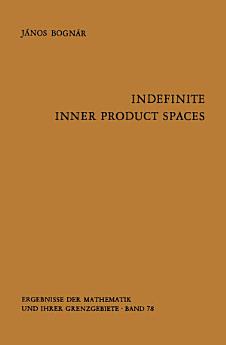Indefinite Inner Product Spaces
J. Bognar
ডিচে ২০১২ · Springer Science & Business Media
৪.০star
২ টা পৰ্যালোচনাreport
ইবুক
226
পৃষ্ঠা
reportমূল্যাংকন আৰু পৰ্যালোচনা সত্যাপন কৰা হোৱা নাই অধিক জানক
এই ইবুকখনৰ বিষয়ে
By definition, an indefinite inner product space is a real or complex vector space together with a symmetric (in the complex case: hermi tian) bilinear form prescribed on it so that the corresponding quadratic form assumes both positive and negative values. The most important special case arises when a Hilbert space is considered as an orthogonal direct sum of two subspaces, one equipped with the original inner prod uct, and the other with -1 times the original inner product. The subject first appeared thirty years ago in a paper of Dirac [1] on quantum field theory (d. also Pauli [lJ). Soon afterwards, Pontrja gin [1] gave the first mathematical treatment of an indefinite inner prod uct space. Pontrjagin was unaware of the investigations of Dirac and Pauli; on the other hand, he was inspired by a work of Sobolev [lJ, unpublished up to 1960, concerning a problem of mechanics. The attempts of Dirac and Pauli to apply the concept and elemen tary properties of indefinite inner product spaces to field theory have been renewed by several authors. At present it is not easy to judge which of their results will contribute to the final form of this part of physics. The following list of references should serve as a guide to the extensive literature: Bleuler [1], Gupta [lJ, Kallen and Pauli [lJ, Heisen berg [lJ-[4J, Bogoljubov, Medvedev and Polivanov [lJ, K.L. Nagy [lJ-[3], Berezin [lJ, Arons, Han and Sudarshan [1], Lee and Wick [1J.
মূল্যাংকন আৰু পৰ্যালোচনাসমূহ
৪.০
২ টা পৰ্যালোচনা
এই ইবুকখনক মূল্যাংকন কৰক
আমাক আপোনাৰ মতামত জনাওক।
পঢ়াৰ নির্দেশাৱলী
স্মাৰ্টফ’ন আৰু টেবলেট
Android আৰু iPad/iPhoneৰ বাবে Google Play Books এপটো ইনষ্টল কৰক। ই স্বয়ংক্রিয়ভাৱে আপোনাৰ একাউণ্টৰ সৈতে ছিংক হয় আৰু আপুনি য'তে নাথাকক ত'তেই কোনো অডিঅ'বুক অনলাইন বা অফলাইনত শুনিবলৈ সুবিধা দিয়ে।
লেপটপ আৰু কম্পিউটাৰ
আপুনি কম্পিউটাৰৰ ৱেব ব্রাউজাৰ ব্যৱহাৰ কৰি Google Playত কিনা অডিঅ'বুকসমূহ শুনিব পাৰে।
ই-ৰীডাৰ আৰু অন্য ডিভাইচ
Kobo eReadersৰ দৰে ই-চিয়াঁহীৰ ডিভাইচসমূহত পঢ়িবলৈ, আপুনি এটা ফাইল ডাউনল’ড কৰি সেইটো আপোনাৰ ডিভাইচলৈ স্থানান্তৰণ কৰিব লাগিব। সমৰ্থিত ই-ৰিডাৰলৈ ফাইলটো কেনেকৈ স্থানান্তৰ কৰিব জানিবলৈ সহায় কেন্দ্ৰত থকা সবিশেষ নিৰ্দেশাৱলী চাওক।




